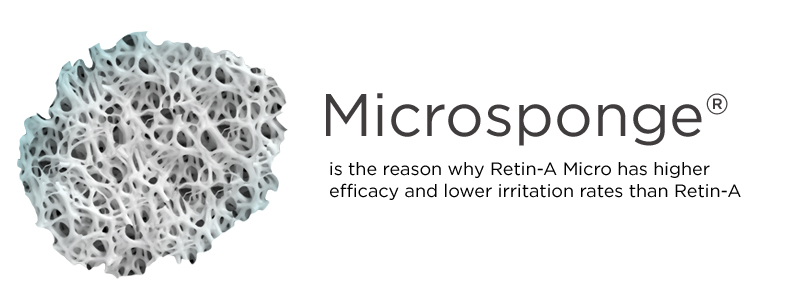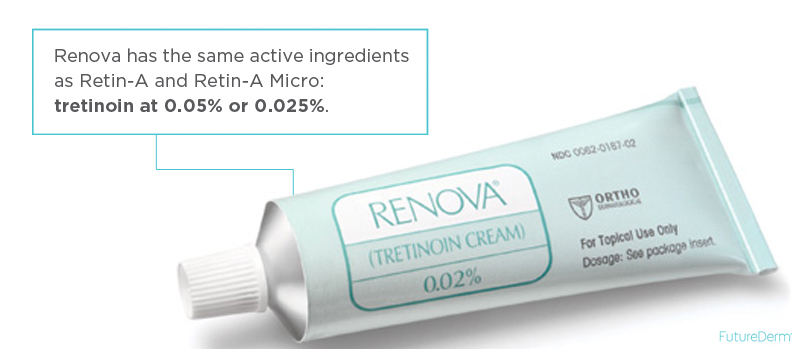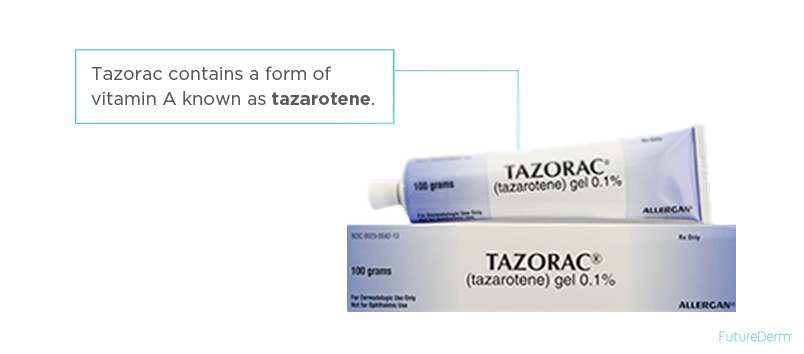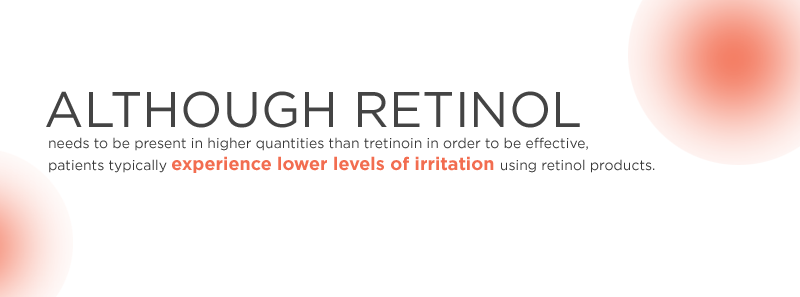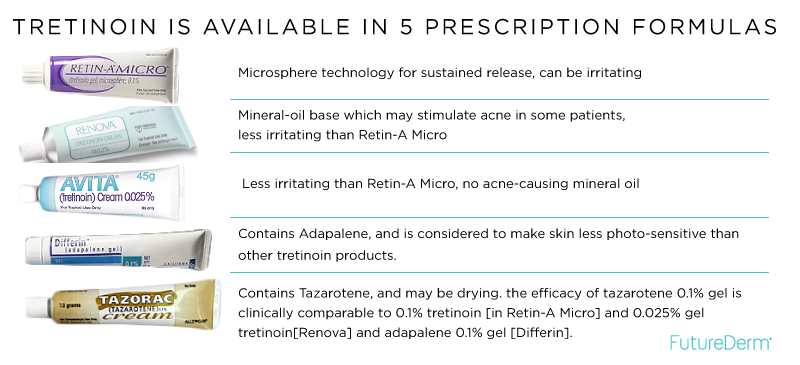Prior to the development of Retin-A in the 1970’s, dermatologists basically relied upon oral Vitamin A to help treat acne, and just a few topical treatments helped with signs of photoaging.
Then Retin-A was developed. Although it was originally used as an acne treatment, Retin-A has numerous uses now, such as treating signs of aging, deeply exfoliating the skin, and acting as a keratolytic agent (an agent that removes a plug out of a hair follicle or sweat gland).
After that, different delivery systems of tretinoin evolved, including microsponge (with Retin-A Micro) and emollient (with Renova). More recently, synthetic forms of tretinoin, including adapalene (Differin) and tazortene (Tazorac) were invented. Here are six things you need to know about Retin-A and the different forms of tretinoin:
[Read More: Know Your Prescription Retinoids: The Differences Between Retin-A, Retin-A Micro, Renova, Differin, and Tazorac]
1.) I always prefer Retin-A Micro to Retin-A.
Retin-A Micro is simply better than Retin-A – the sustained Microsponge® systems technology enables the retinoid to be active in your skin for a longer time.
How does it work? The Microsponge® system prevents the accumulation of excessive medication within the surface layers of the skin. Each Microsponge® is less than one-thousandth of an inch of diameter, holding a small amount of tretinoin in reserve and introducing only small amounts of tretinoin to the skin over time.
The Microsponge® is the reason why Retin-A Micro has higher efficacy and lower irritation rates than Retin-A. Your skin never gets more vitamin A than it can handle at one time.
Retin-A Micro is superior for those with oily and sensitive skin types, due to there being more shine reduction and less irritation potential than with traditional Retin-A.
The only reservation? Money. Retin-A Micro is significantly more expensive than Retin-A, at $244.44 and $90, respectively, although the price may vary depending on your insurance.
2. If your skin is rough, you may prefer Renova to Retin-A.
Renova has the same active ingredients as Retin-A and Retin-A Micro: (tretinoin at 0.05% or 0.025%.)
The difference? Only Renova is U.S. FDA-approved for the treatment of skin surface roughness following UV exposure, including fine facial wrinkles and brown spots.
The reason why Renova is significantly better than Retin-A or Retin-A Micro for treating skin aging is due to its emollient system, which prevents irritation (Biomedical and Life Sciences). Renova softens and soothes the skin once it is absorbed, so patients typically have much better compliance, sticking with it far longer than Retin-A or Retin-A Micro.
Since your skin only turns over once every three to four weeks as an adult, it takes this long to see reductions in fine facial wrinkles and brown spots. Since a lot of people have given up on Retin-A or Retin-A Micro in this time, it makes Renova the better choice for skin aging.
3. Differin does NOT the same active ingredient as Retin-A, Retin-A Micro or Renova. It may be better for acne.
People often think that all retinoids are the same, but in fact they are not. Differin is a form of tretinoin called adapalene at 0.1%. Tazorac is a form of vitamin A called tazarotene at 0.1%.
Differin contains adapalene, a derivative of napthoic acid. Differin possesses similar biological properties of tretinoin, but has higher solubility in fats and oils, and increased photostability (i.e., stability in light).
Differin is also a lot more targeted than Retin-A or Retin-A Micro. Differin only binds to specific receptors within the skin, RAR-β and RAR-γ, whereas Retin-A or Retin-A Micro binds to a multitude of proteins.
What this means for practical purposes is that differin is great for cutting through oil and treating acne. At 12 weeks, the combination has been shown to significantly reduce total, inflammatory, and non-inflammatory acne lesions (SKINmed). It has also been shown to have fewer side effects than tretinoin (British Journal of Dermatology).
[Read More: 11 Things That You Never Knew about Retinol and Retinoids – Until Now]
4. Tazorac also does not have the same form of vitamin A as Retin-A, Retin-A Micro, or Renova. It may be better for psoriasis.
Tazorac contains a form of vitamin A known as tazarotene.
Tazorotene is the first retinoid formulated specifically for psoriasis. Like Differin, Tazorac only binds to specific receptors in the skin, RAR-β and RAR-γ.
But if you’re considering Tazorac for treating fine lines, wrinkles, and other signs of UV damage and aging, you may want to reconsider.“There is limited evidence that tazarotene [may] benefit patients with moderate photodamage on the face.” (Evidence-Based Medicine).
5. Retinol is about 20 times less potent than tretinoin (Retin-A, Retin-A Micro, Renova).
Retinol, unlike tretinoin, adapalene, or tazarotene, is sold over-the-counter.
Retinol has incredible efficacy but is technically still a cosmetic rather than a drug. This is because retinol must be activated within the skin before it can do anything: retinol must first be converted to retinaldehyde, and then a compound called all-trans retinoic acid within the skin in order to be effective.
In general, retinol is considered to be about 20 times less potent than retinoic acid, ounce for ounce. So a 0.025% tretinoin is like a 0.50% retinol. A 0.050% tretinoin is like a 1.0% retinol.
Although retinol needs to be present in higher quantities than tretinoin in order to be effective, patients typically experience lower levels of irritation when using retinol products. This may be due to the time it takes for retinol to convert to all-trans retinoic acid within the skin.
6. Retinyl palmitate is even weaker than retinol. I do not advocate its use as a standalone “active” ingredient.
Retinyl palmitate is a combination of pure retinol and palmitic acid (a substance typically used in cosmetics as a cleansing agent).
Retinyl palmitate must be broken down into retinol and palmitic acid, and then the retinol must still be converted to retinaldehyde and then all-trans retinoic acid within the skin in order to be effective.
It is true that retinyl palmitate present in sufficiently high concentrations can have efficacy similar to that of retinol. But have you ever seen a skin care product say “5.0% retinyl palmitate?” No. Manufacturers of retinyl palmitate don’t dare suggest the concentration of retinyl palmitate, because it leads to questions they don’t want to answer. They know it doesn’t do much, if anything.
You’ll sometimes see retinyl palmitate added towards the bottom of ingredient lists in products. If they’re great products aside from the retinyl palmitate, I’ll still advocate for them. But I will never advocate a product because it contains retinyl palmitate, at least not until I see one that dares to list its concentration (and it had better be 3% or higher)!
[Read More: Which is Better: Retinoids or Peptides?]
Bottom Line
When we go to the dermatologist for skin aging, we’re almost all brainwashed to ask for Retin-A or Retin-A Micro.
But consider the following:
- Retin-A Micro has better efficacy than Retin-A.
- Renova has been shown to have better results for treating signs of sun damage than Retin-A or Retin-A Micro, with typical use.
- Differin may be better for people with acne who also want to improve their skin.
- Tazorac may be better for people with psoriasis who also want to improve their skin.
- 0.025% tretinoin is similar to 0.50% retinol.
- 0.050% tretinoin is similar to 1.00% retinol.
- Retinol is far more effective than retinyl palmitate.
[Read More: Which Products Should I Use After Retinoids?]
Hope this helps!
Looking for the best skin care? FutureDerm is committed to having its customers find — and create — the best skin care for their individual skin type, concern, and based on your ingredient preferences. Learn more by visiting the FutureDerm shop!


